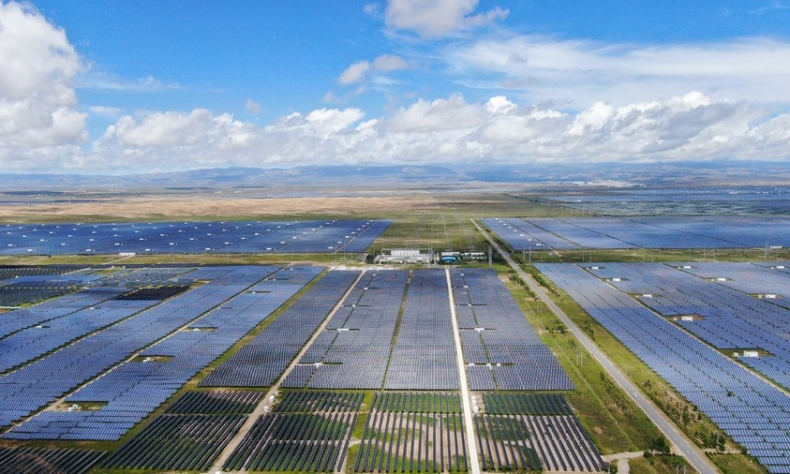China’s Green Energy Initiative

Keeping in mind the dynamic international political and economic environment and changing climate with each passing day threatening the planet, China is playing a constructive role, so the global community must work together for a shared prosperous and secure future.
The annual meeting of the National People’s Congress held in March adopted the 14th Five-Year Plan (2021-2025) for the national economic and social development and the long-range objectives through the year 2035. In this plan, China focuses on building green energy infrastructure including climate and energy policies for the next decade.
This is in continuum to the announcement made by Chinese President Xi Jinping at the annual UNGA Summit last September that China would reduce its carbon emissions to net zero by 2060. This vision of President Xi is deeply embedded in China’s modernization goals. The 14th Five-Year Plan is momentous in the country’s climate actions for it formulates accomplishment plans in handling carbon emissions and thus anchors the change in carbon footprint to neutrality by the sixth decades of the 21st century. This target is 10 years earlier than the adopted deadline by most of the countries as per the guidance from the Paris Climate Agreement. As the world is grappling with deteriorating climate change effects and global rise in temperatures, China is acting as a responsible country by placing a high priority on shifting its requirements towards green energy resources. This commitment is grand but not impossible to achieve when there is committed and focused leadership of Communist Party of China (CPC). This initiative will not only resolve China’s own national level climate change challenges but help tackle regional and global climate crisis. As the journey of thousand miles begins with a single step, China has begun making its constructive contribution to safety and security of the planet and humanity.
China is the second largest economy of the world, but it may overtake the US in coming years, as the IMF’s 2020 World Economic Outlook and reports from other financial institutions show that China’s economy is one-sixth larger than the US economy in PPP ($24.2 trillion vs $20.8 trillion). China also accounts for 30 percent of the world’s greenhouse gas emissions. The country is home to 22 percent of the world population and covers the third largest land mass of the planet. While reaching the most important goal of poverty reduction and championing the millennium development goals, there is a boost in industrialization in China. The energy needs are rising with each passing day, both conventional and unconventional, making China close to the second largest energy consumer of the world.
In fulfilling its responsibility, however, China is not only making good use of conventional and unconventional energy resources but also constantly shifting towards green energy. The country is becoming the world leader in producing renewable energy surpassing the US especially in the production and use of the latest technology and methods. Recent report by Global Commission on the Geopolitics of Energy Transformation, an independent initiative launched by the International Renewable Energy Agency (IRENA) holds that China is in a better position to become the “world’s renewable energy superpower”. This is an important global recognition for the CPC leadership’s vision and mission. Currently most of the energy in China comes from fossil fuels, particularly coal, however, there is also a gradual shift now. According to the International Energy Agency, nearly 40 percent of the global renewable energy from wind and solar stems from China.
Advancement in science and technology is facilitating China to be the center of global-climate-action gravity, creating ripples across the globe encouraging nations to follow suit. The country is leading and offering several important initiatives including new renewable energy tools, power generation mechanisms and innovative products and methods to help reduce carbon footprint. Specifically, China is ramping up the production of efficient solar panels, electric cars and other new energy vehicles, robotic machines with energy efficient mechanisms, wind turbines and solar photovoltaic panels, to meet global demands.
It is said that Chinese companies produce nearly one third of the world’s solar panels with ever increasing demands especially after the firm realization by the global community to use effective green energy. This entire drive of China for contributing towards global climate action is building China’s global image as a responsible global power. Climate threat is exposing the countries on this planet to great danger with rising temperatures and increase in carbon emissions, making life on earth on the verge of mass extinction. As a responsible leading economic power, China, with its renewed energy policies, is focusing on important measures to achieve China’s goal of establishing an environmentally friendly society and economy. China is clearly following the global trend and laws for green, efficient and low carbon neutrality targets set forth by the Paris Climate Agreement.
The Belt and Road Initiative (BRI) is a modern silk road with 138 countries taking part in this huge investment, connectivity and economic project announced in 2013. With massive development on sea and land routes, the BRI, President Xi’s vision, has also been translated here through joint efforts to support and save the environment. As a result of the deliberations on the second BRI forum in 2019, the BRI International Green Development Coalition was established supervised by the Chinese Ministry of Ecology and Environment. This coalition is open to the public and private stakeholders, governments, think tanks, local and international organizations and civil society organizations. Currently, the coalition has attracted 130 international and Chinese organizations.
Again, as a responsible international actor, China is investing more in the BRI environment and energy initiatives to ensure renewable energy should be used. Similarly, in China Pakistan Economic Corridor (CPEC), one of the important pillars of BRI, all the energy projects are in compliance with the global standards where Pakistan, with the support from the Chinese government, is playing its role in environment protection at all levels. China has also built one of the largest solar panels park known as Quaid-I-Azam Solar Park. Of all projects under CPEC, nearly 13 renewable energy projects are well under way, creating efficient and green energy for Pakistan’s industrial and economic growth.
This journey towards green energy revolution of China is a path to opening-up to the world by enforcing new and innovative governance mechanisms to handle the rapidly changing global economic and political environment. This drive is aimed at both enhancing economic and financial growth and rebuilding people’s lives in the country which truly reflects a People’s Republic. China is contributing towards global ecological civilization through improving global climate situation by means of new ways and methods in energy. Keeping in mind the dynamic international political and economic environment and changing climate with each passing day threatening the planet, China is playing a constructive role, so the global community must work together for a shared prosperous and secure future.
 Facebook
Facebook
 Twitter
Twitter
 Linkedin
Linkedin
 Google +
Google +



